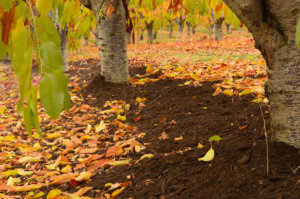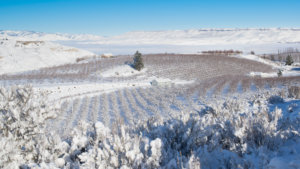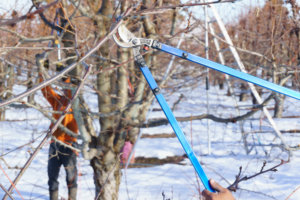Winter in the Orchard
|
Originally published in December 2015; updated January 2023.
Winter is the orchard’s natural time of rest. While the fruit trees are in dormancy, they’re simultaneously storing energy and nutrients that will allow them to grow apples, pears, cherries, and stone fruits with delicious flavor for the next harvest season. The cold winter temperatures are essential to fruit trees. They may be under a thick blanket of snow, but percolating away like a rich amino acid soup, a nutrient-packed compost sits on the roots so the fruit explodes with sweet flavors! Winter is the best time to ensure each tree reaches its full potential. Read on to learn more about Winter time in Stemilt’s Orchards!
Why is Snow Good for Trees?

- Snow is an insulator for fruit orchards in the winter. It serves as a blanket for trees to protect their roots from freeze during severe cold temperatures.
- High elevation orchards get a later start to spring because the snow there is the last to melt
- Compost is applied to the base of the trees in the fall. As spring nears and the snow melts, the compost is fed deep into the trees’ roots in order to deliver the best nutrients throughout the growing season.
What is Winter Chill?
Winter Chill is the amount of hours that the temperatures fall in a range of 32 to 45 degrees for apples and pears, or 35 to 55 degrees for cherries or summer stone fruit. All fruit orchards (apples, pears, cherries, peaches, nectarines, and apricots) need winter chill to rest and prepare for the next season’s crop.
- One hour of winter chill temperatures equals one chill unit.
 Apples need 500 to 1100 chill units, pears need 500 to 1500 chill units, and cherries and summer fruit need 800 to 1600 chill units.
Apples need 500 to 1100 chill units, pears need 500 to 1500 chill units, and cherries and summer fruit need 800 to 1600 chill units.
- Winter chill helps fruit trees store energy for the upcoming growing and fruiting season
- Orchards that have proper chill will produce a more flavorful and higher quality crop
Why do we Prune Fruit Trees in the Winter?
During the winter (and when temperatures aren’t too cold), growers and their crew use a tool called loppers to prune every tree in the orchard. It’s a tedious but necessary step in ensuring a great crop come summer (for cherries and stone fruits) or fall (for apples and pears). To learn more about pruning, check out the blog Apple Pruning.
- Trees are dormant, or in a resting state, during the winter season
- This is the best time for growers and their crews to prune trees
- Each tree is pruned carefully to ensure great sunlight penetration for producing fruit
- Pruning allows growers to balance the crop load on their trees
- Pruning balances leaves and fruit growth in the spring and summer to deliver high quality fruit in better sizes
Follow along with us in the videos below to learn more about applying compost in the fall and the importance of winter snowfall with Kyle Mathison!
Excited for harvest season yet? We are too! When apples and pears are finally ready for the picking, pick up your spoons and spatulas and be sure to check out More Winter Recipes here!


